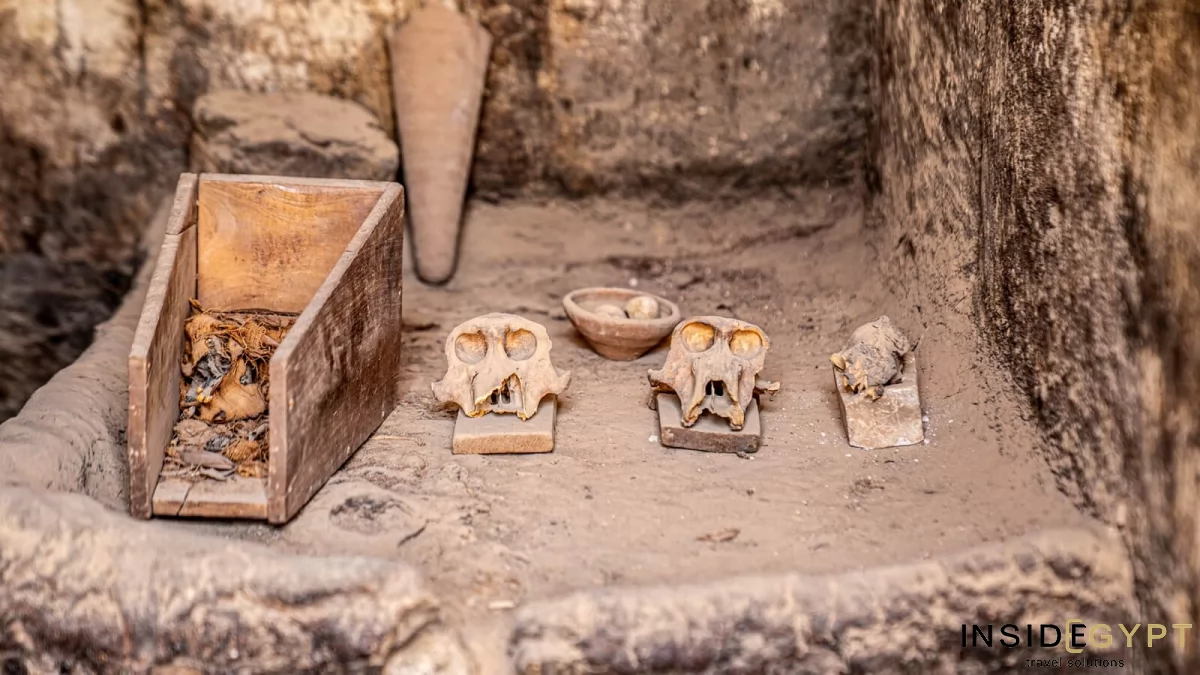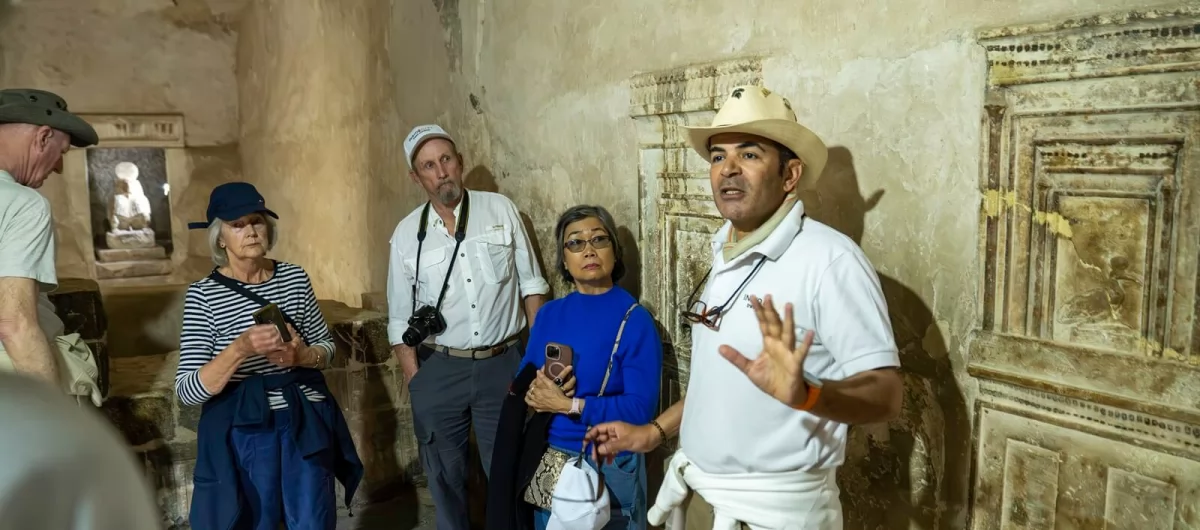Stay updated!
Tuna el-Gebel, or Tunah al-Jabal, is a significant archaeological site in Middle Egypt, famous for its extensive necropolis and well-preserved Greco-Roman tombs. It reveals the cultural importance of the ancient city of Hermopolis, showcasing burial practices and artistic achievements of the time. The tombs of Tuna el-Gebel offer valuable insights into ancient Egyptian religious practices and beliefs in the afterlife, making it a must-visit destination for history enthusiasts.
For travelers interested in exploring the fascinating tombs of Ancient Egypt, we recommend taking a tour of Tuna el-Gebel, where you can discover the Temple of Thoth, the unique catacombs of ibises and baboons as well as explore the tomb of Petrosis and the tomb of Isadora, complete with her mummy.
Visit Tuna el-Gebel with Inside Egypt, where we offer exclusive, high-end tours designed to bring this remarkable site to life.
Our expertly guided excursions allow visitors to delve deep into the history and significance of this archaeological gem. Engage with knowledgeable guides who share compelling stories about the site's past and its role in the cultural landscape of ancient Egypt.
We offer a great opportunity to experience the wonders of Tuna el-Gebel during our Egypt private tours or long Nile cruise from Cairo to Aswan and more. This unique journey occurs only once a year in early spring, allowing travelers to explore the rich history of the region while enjoying the scenic beauty of the Nile.
Join us for an unforgettable adventure through time and discover the treasures of this extraordinary site, where ancient history comes alive and offers a deeper understanding of Egypt's fascinating past.
Discover Egypt's secrets with Inside Egypt! Book your Egypt tour package!
Photos of Tuna el-Gebel







Discover Our Exclusive Egypt Tours
Tour Reviews
FAQ About Tuna el-Gebel
What is the significance of Tuna el-Gebel?

Tuna el-Gebel is a significant necropolis for the ancient city of Hermopolis, located in Middle Egypt. This site embodies the cultural and religious practices of the Greco-Roman period within ancient Egyptian civilization. The necropolis contains impressive ancient tombs built between the 8th century BC and the 4th century AD, showcasing a unique fusion of Egyptian and Greek architectural styles, making it a remarkable area for archaeological exploration.
Among the notable discoveries at Tuna el-Gebel is the tomb of Petosiris, a priest of Thoth. Resembling a Ptolemaic temple rather than a traditional tomb, it features a pronaos with four beautifully decorated columns, establishing its importance as a sacred site. The interior showcases a blend of Egyptian and Greek artistry, where reliefs depict the lives of farmers and craftsmen in a distinctive, non-traditional perspective. Despite these influences, the core themes of funerary art remain deeply rooted in pharaonic traditions.
The tomb of Isadora adds a romantic narrative to the site, reflecting the human experiences and emotions tied to burial practices. Additionally, the sacred burial grounds for ibises and baboons highlight the reverence for these animals as embodiments of Thoth, providing key insights into religious syncretism during this period.
Overall, Tuna el-Gebel is not just a significant archaeological site but also a window into the rich history and evolution of ancient Egyptian spirituality, illuminating the interactions between Greek and Egyptian beliefs in a vital urban center.
Is there anything more to do around Tuna el-Gebel?
.webp)
When visiting Tuna el-Gebel, there are several nearby attractions that can enhance your experience in Middle Egypt. Just a short distance away lies the ancient city of Hermopolis Magna, renowned for its fascinating ruins and significant connection to the worship of Thoth, the god of wisdom and writing. Exploring these remains allows visitors to gain a deeper understanding of the religious practices that shaped the region.
Additionally, consider visiting Al Minya city, where the Aten Museum showcases an array of artifacts that reflect the region's rich history and culture. Here, you can engage with local traditions and enjoy the vibrant atmosphere of a bustling Egyptian city.
For those interested in further archaeological exploration, Ashmunein is also nearby, featuring remarkable remnants of ancient Egyptian tombs and temples that shed light on the area's historical significance.
By exploring these diverse attractions, you can create a rich and varied itinerary that offers a comprehensive glimpse into the heritage of Middle Egypt. Each location enhances the narrative of ancient Egyptian civilization and provides unique experiences for travelers eager to delve deeper into this storied region.
How do I visit Tuna el-Gebel?

To visit Tuna el-Gebel, located approximately 100 km south of Al Minya city, you can expect a drive of about 1 hour and 20 minutes by car from Minya. If you're traveling from Cairo, the site is at a distance of 330 km to the south, which takes about 4 hours by car. Various transportation options are available, including rental cars and private taxis, offering flexibility and comfort.
However, navigating to this remote location can be challenging. To simplify your journey, consider joining one of Inside Egypt's private guided tours of Tuna el-Gebel. These tours provide comprehensive access while offering expert insights into the significance of this remarkable archaeological site. Since group tours are rarely organized to Tuna el-Gebel, a private tour ensures a tailored experience rich in historical context.
Inside Egypt also hosts a long Nile cruise each spring, allowing you to experience Tuna el-Gebel alongside other lesser-known archaeological sites in Middle and Upper Egypt like Beni Hasan, Tell el-Amarna, Abydos, and Dendera. This option is perfect for history and archaeology enthusiasts eager to delve deeper into Egypt's past.
When is the best time to visit Tuna el-Gebel and Middle Egypt?
.webp)
The best time to visit Tunah al-Jabal is during the cooler months from October to April. This period offers comfortable temperatures, making it ideal for exploring the fascinating tombs of Tuna el-Gebel. During these months, daytime temperatures can range from 20°C to 30°C (68°F to 86°F), allowing visitors to enjoy outdoor tours without the discomfort of the extreme summer heat.
The summer months can reach scorching highs exceeding 40°C (104°F), which may limit outdoor activities. By choosing to visit during the cooler season, tourists can fully enjoy their Tuna el-Gebel tours, immersing themselves in the rich history and stunning archaeological sites at a more pleasant pace.
Inside Egypt's carefully planned itineraries ensure that visitors experience the best of Tuna el-Gebel year-round, with experienced guides ready to provide insights into the significance of the location. Whether you're there to admire ancient architecture or delve into the fascinating history of this site, planning your visit between October and April will enhance your experience.
Discover Our Exclusive Egypt Tours

Embark on a journey like no other with Inside Egypt. With intimate groups of just 20 travelers, our journeys offer incredible VIP access to the Giza Plateau, the Great Pyramid and the Great Sphinx, luxury accommodation, and expert insights. Explore Egypt's cultural treasures with Egyptologists who stay with you every step of the way.
Here are our exclusive tour packages:
- Long Nile Cruise from Cairo to Luxor and Aswan: Experience an unforgettable visit to Tuna el-Gebel, alongside many other iconic sites.
- 15-Day Egypt Tour: Explore Egypt and the enchanting Siwa Oasis with a focus on cultural immersion.
- 14-Day Egypt Tour: Our most popular package, combining key historical locations with deep local insights.
- 12-Day Red Sea Tour: A perfect blend of exploring Egypt's ancient wonders and enjoying a relaxing Red Sea holiday.
- 10-Day Egypt Tour: Highlights of ancient Egypt paired with enriching cultural experiences.
- 8-Day Egypt Tour: Capture the essence of Egypt with a well-rounded itinerary.
- 7-Day Egypt Total Solar Eclipse Tour: A unique opportunity to witness a solar eclipse while exploring Egypt's treasures.
These exclusive tours provide you with a personalized service and are a seamless way to uncover Egypt. Join us for a journey that leaves you enriched and inspired!
What People Say About Our Tuna el-Gebel Tours

At Inside Egypt, we pride ourselves on providing exclusive tours that allow our guests to immerse themselves in the rich history and ancient wonders of Tuna el-Gebel. Our knowledgeable guides enhance each experience, offering in-depth insights that bring the past to life. We prioritize your comfort throughout the journey, utilizing high-quality means of transport and offering luxurious accommodation, including a long Nile cruise from Cairo to Aswan. This ensures that you travel in style and relaxation, allowing you to fully enjoy your exploration of Egypt's treasures. Here's what some of our satisfied customers have to say about their journeys:
"I first visited the tomb of Petosiris, a high priest of Thot from around 300 BC. The wall paintings beautifully combine styles from the Old Kingdom and Greek influences. The tomb of Isidore dates to the second century AD and features her mummy on display, along with a poignant story of her tragic fate. Our guide highlighted numerous pharaonic artifacts found in the area, enhancing the experience as we ventured into the catacombs, where we saw the fascinating mummy of a baboon and remnants of ancient pottery."
"During a day tour from our long Nile cruise from Cairo to Luxor and Aswan, I was captivated by the stunning reliefs in the Tomb of Petosiris. The artwork blends traditional Egyptian scenes with Greek stylistic elements, creating an absolutely beautiful experience. The Tomb of Isadora felt atmospheric, even though it was quite bare, thanks to the presence of her mummy. I was also impressed by the well-lit underground catacombs, filled with interesting tunnels and plenty of broken pottery."
"The Tomb of Petosiris resembles a small temple and retains much of its original color, showcasing vibrant scenes from daily life—truly a hidden gem. Next to it lies the simpler Tomb of Isadora, with her mummy still inside, creating a unique ambiance. While the entrance has a challenging staircase, the catacombs nearby encompass the remains of thousands of ibises and baboons. Although many halls are now inaccessible due to preservation efforts, the site remains a fascinating and often-overlooked destination for travelers."
These testimonials reflect the value and enriched experiences that Inside Egypt provides. We ensure that every journey is both comfortable and enlightening.





